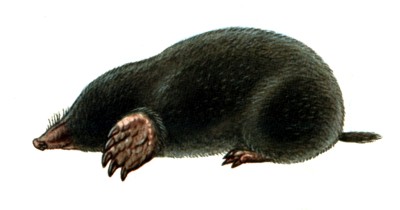Pests
Talpa europaea L. - European Mole
Systematic position.
Class Mammalia, order Soricomorpha, family Talpidae, genus Talpa. Four of 15 subspecies are known in the territory of the former USSR. Karyotype is 2n = 34, FN = 68.Biological group.
Pest of agricultural crops and pastures.Morphology and biology.
Body length is 120-165 mm; tail length is 28-42 mm; length of hind foot is 17 mm. Weight is 60-110 g; average weight is 90 g in males, 70 g in females. Elongated snout projects forward beyond cutters by a distance almost equal to width of naked disk. Eyes are visible from outside, having mobile eyelids. Color of velvety fur varies depending on illumination. The color is mat-black against the light, brilliant gray-blackish along the light. The body ventrum is somewhat lighter than the dorsum. The tail has apical brush of hairs. Color aberrations of fur are rather common, from white with pale-yellow shade to gray and brown. The European Mole molts 3 times in a year; i.e., in spring, in summer, and in autumn. Coupling occurs in March-April; duration of pregnancy lasts 40 days. There are 1-2 litters with 3-9 (5 on the average) youngs per litter. Sex ratio is about 1:1 depending on the life cycle period. Terms of reproduction within the area are from the end of February-March in the south to May at the northern border of distribution. A phenomenon of the second pregnancy occurring in period of depression is known for some part of females in the mole populations.Distribution.
Forest and forest-steppe zones of Europe and Asia, from the northern part of Iberian Peninsula in the West to western Siberia in the East, and from Scotland, southern Sweden, western Finland and Karelia (Russian Federation) in the North to Mediterranean Sea coast and Moldova in the South.Ecology.
Moles of this species populate mixed and deciduous forests, meadows, kitchen gardens, gardens. In forest biotopes the moles are spread along edges, small glades, and thin sites. Migration out of forests and forest plantings occurs along relief depressions, river flood-lands, irrigation channels, roadsides. The animals eat earthworms, larvae and adults of insects, spiders, mollusks and multipeds; sometimes they make small stores, basically of earthworms. Mole numbers decrease at droughts, excessive humidifying of soil, high waters, incessant rains, also in winters with little snow cover and deep soil freezing.Economic significance.
Economic significance is various. Exterminating insects and their larvae, the moles are useful to agriculture and forestry. They are soil-forming animals in forest biocenoses. However, transfer of poor earth layers on a surface, as a result of digging activity, contributes to deterioration of meadows and pastures and to their weediness. Moreover, molehills impede qualitative hay harvesting by machines. At high number the moles have negative influence, causing shrinkage of plants because of their root system damage. Agricultural expert estimation has shown that yield losses of winter and tilled crops did not exceed 1.0-1.5% in 1986-88 within the mole area in the territory of the former USSR. In contrast, the damage can be considerable in hothouses, on berry plantations, in young gardens, nursery forests, and kitchen gardens even at insignificant mole population density. The chemical method is not recommended as a protective action. Catch by traps of different modifications is the main tool to decrease the mole numbers. Inundation of burrows by water is possible, but ineffective. Recently low frequency repellent devices of new generation have appeared, allowing protection of 1,000 sq. m area by one device from settling moles. The European Mole is a valuable trade animal. In 1971-75, 5.9-13.4 million skins per year were prepared. 90% of mole skins were yielded in Russia and 10% in Ukraine and Belarus. In 1976-86 in Belarus, annual skin yield reached 326.3 thousand pieces on average; its increase to 2 million pieces was predicted.Reference citations:
Anonym. 2008. Apparatus to repel the Moles. Additional information. http://tp.by/kroty.htm (in Russian).Anonym. 2005. Talpa europaea. Wilson & Reeder.s Mammal Species of the World. Third Edition. Bucknell Univesity. http://www.departments.bucknell.edu/biology/resources/msw3/browse.asp?id=13700730
Gromov I.M., Gureev A.A., Novikov G.A., Sokolov I.I., Strelkov P.P., Chapskii K.K. 1963. Mammals of the USSR fauna. Part 2. In: Pavlovskii E.I., ed. Moscow, Leningrad: Izdatel.stvo Akademii Nauk SSSR, 639 p. (in Russian).
Hutchins M., Kleiman D.G., Geist V., and McDade M.C., eds. 2003. Grzimek.s Animal Life Encyclopedia, 2nd edition. Vol. 13, Mammals II. Detroit et al.: Farmington Hills, MI: Gale Group, 580 p.
Kononov S.I. 1990. Prospects of moleskins purchasing in BSSR. In: Proceedings of 5th All-Union Teriological Society of AN SSSR. V.3. Moscow, p. 99 (in Russian).
Mironov A.D., Bublichenko A.G., Verevkin M.V., Gerasimov S.V. 1989. Report on the research work: Development of recommendations to prevent harmful activity of the European Mole in agrocenoses. Leningrad, 77 p. (in Russian).
Ognev S.I. 1928. Beasts of Eastern Europe and Norstern Asia. Part 1. Moscow-Leningrad, 631 p. (in Russian).
Pavlinov I.Ya., Kruskop S.V., Varshavskii A.A. & Borisenko A.V. 2002. Land animals of Russia. In: E.A.Dunaev & K.G.Mikhailov, eds. Manual-Identification book. Moscow: KMK. 298 p. (in Russian).
Pavlinov I.Ya., Rossolimo O.L. 1987. Taxonomy of the USSR mammals. In: Sokolov V.E., ed. Moscow: Moscow University, 284 p. (in Russian).
Sidlyarevich V.I. 2001. European mole. Akhova raslin (6): 41 (in Russian).
Stroganov S.U. 1957. Siberian beasts. The insectivores. Moscow: Izdatelstvo Akademii Nauk SSSR, 268 p. (in Russian).


